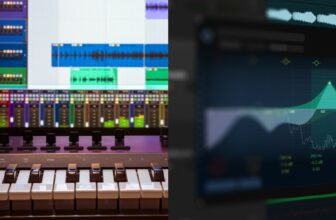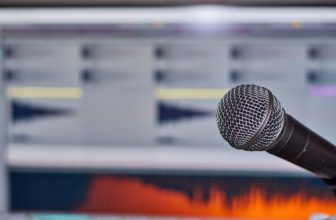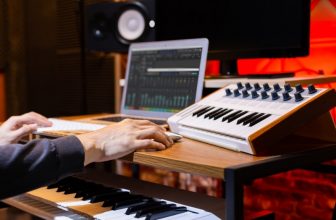Reaper vs Pro Tools – Which One Should You Use?

Pro Tools has been the most preferred Digital Audio Workstations in most professional studios for a long time now but with a high price tag and disappointing software updates has opened the market for other Digital Audio Workstations. One such Digital Audio Workstation is the relatively affordable Reaper that offers more regular updates.
With more people producing from the comfort of their home studios, affordable Digital Audio Workstations make more sense to invest in to start. With more technological advancements, the most affordable options also offer similar features.
With Reaper, you can get free video resources to learn almost everything available on their website. Pro Tools, on the other hand, offers a much wider variety of hardware resources like Avid Dock, S1, S3, S4, S6, Avid Control, etc to have much more control and hands-on feel and control on your projects.
| Reaper | Pro Tools First | Pro Tools | Pro Tools Ultimate | |
| Tracks | Unlimited | 16 (mono/stereo)16 MIDI16 Instrument | 256 (mono/stereo)1024 MIDI512 Instrument | 2048 (mono/stereo/surround)1024 MIDI512 Instrument |
| Compatibility | Mac and Windows | Mac and Windows | Mac and Windows | Mac and Windows |
| Trial | 60 days | Free | 30 days | 30 days |
| Price | Affordable | Free | High End | Marketed for Pros |
| Hardware Resources | None | Few selected ones | A good amount to choose from | More than 20 to choose from |
| Plugins | VST2 and VST3 format | AAX format 64-bit | AAX format 64-bit | AAX format 64-bit |
Contents
Key Differences Between Pro Tools and Reaper
- Reaper has a very customizable interface that can be fine-tuned according to your workflow and needs. It is built with an open-source nature which allows greater control over how your workflow is. Pro Tools on the other hand offer very little to no option for customization of the interface. You have to learn and get comfortable with what you get.
- Reaper supports VST2 and VST3 format plugins for both 32-bit and 64-bit versions. This offers more flexibility for some artists who can be on a tight budget or just starting their musical journey. Most of the freeware plugins come in VST format with some offering VST3 support. Pro Tools on the other hand works on AAX format with 64-bit support only. A lot of freeware plugins are usually not available in this format so you should consider this if you are on a tight budget.
- stock plugins on the other hand are better in Pro Tools. The user interface and overall experience of using the plugin are far better in Pro Tools as compared to Reaper. Reaper stock plugins are not very pleasing to the eye. Although they work perfectly well the overall aesthetics make you want to use some other third-party plugin instead.
- Pro Tools has been an industry standard for a long time now. The entire digital music industry was practically built around Pro Tools so if you plan to get into professional recording studios or want to work in one then I would recommend going with Pro Tools instead of Reaper.
- If you plan to build your workflow and/or career around recording and editing audio instead of working with sample instruments, then Pro Tools will help you because most of the professional recording studios use Pro Tools. Although Reaper is very capable of handling recording as well.
- Reaper is generally much more affordable as compared to Pro Tools. Pro Tools come with a big name and history with them, so the price tag Is also a big one. This price tag only gets bigger if you start looking for additional hardware options.
- Hardware accessories are supported by both Digital Audio Workstations, but Reaper does not have any exclusive hardware option to choose from. It supports most third-party hardware so you will be getting great results with them as well. However, Pro Tools comes with all sorts of hardware options to choose from. These hardware options work extremely well with the Digital Audio Workstations as they are designed to work with them specifically. Pro Tools also supports other third-party hardware so the ones you already have will still work with the Pro Tools.
- Both Pro Tools and Reaper are two of the Best DAWs available.
Interface
The user interface of Reaper is basic looking with an arrangement section on top. It contains tracks on the far left and the rest of the screen is dedicated to arranging and editing the audio. There is a taskbar on top with basic default tools which is fully customizable according to your needs. The mixer section on the bottom is separated by the session control bar with all the main control options available. The mixer section at the bottom of the screen looks like an actual mixer to make it easy for the user to control the tracks and have better control which helps in improving the workflow.
The user interface of Reaper is not aesthetically pleasing. Although you have the option to fully customize it and change it according to your comfort, it can get overwhelming with the number of free themes available. It is also a time-consuming and difficult task to learn and apply the small changes according to your needs. This results in a break in your creative workflow sometimes and you may not feel encouraged enough to write songs at times.
That said if you are willing to put in extra time and effort to learn to save a lot of money then the resources to learn are easy to find. The official website of Reaper has a video tutorial section that covers almost all the topics required to learn and adapt to Reaper’s workflow. The content available is more than enough to get comfortable with Reaper. Apart from that, you can find tutorials easily on YouTube and other educational websites as well.
Pro Tools on the other hand offers a much better interface aesthetically which is much more pleasing to the eye. I won’t say it is the best interface to work on available in the market, but it is better than Reaper. On the far left, there is a list of all the tracks and groups. Then comes the track bar which has individual track controls followed by the arrangement window. The taskbar at the top has all the required controls for quick access. The main playback controls are also at the top bar. The mixer window can be brought up to sit at the bottom of the screen to get a more authentic feel of working in a studio environment.
The drawback of Pro Tools is there is little to no scope for personalization or customizing. With the new 2021 version, they added a dark mode to have a choice with just a different colour scheme but other than that you are pretty much stuck to the default view and controls you get. You must adjust and build your workflow around the already fixed template of Pro Tools. This can be a problem for experienced professionals working on other Digital Audio Workstations to get a proper creative workflow as they will have to learn the software first and not just customize it according to their workflow.
Some free tutorials are available on the Pro Tools website, but they are pretty limited and nowhere near to ones Reaper’s website has. Avid, the parent company of Pro Tools, also offers courses to be certified users if you are planning to apply in a professional studio.
Hardware and Software Controllers
Pro Tools has many different hardware and software controller options to choose from. Pro Tools system cards and interface are products that are specifically designed and supported to use with Pro Tools. They are input/output devices and other hardware used for a smoother and latency-free workflow.
Avid control surfaces are also a range of products that are specifically designed to work with Pro Tools to give the best hands-on experience and workflow while using the software to its maximum capabilities. A/V interfaces are also available which are designed to give the best results while working with Pro Tools. All these hardware and software resources will cost you relatively more but if you do end up using them, I can assure you that they won’t disappoint.
Reaper on the other hand does not offer any hardware or software controller options. The only way is to use a third-party controller to configure and use the software.
Both Digital Audio Workstations however work equally well with third-party hardware and software controllers.
CPU Usage
Reaper is easy going on your CPU and will perform much better on a lower-end workstation as compared to Pro Tools. Pro Tools has been known to crash and have problems with lower configurations. Because of the open design of Reaper. It is much more efficient while working with audio or plugins. It is highly efficient and gives you great results by compromising the aesthetics.
In comparison, Pro Tools needs a higher-end workstation for efficient workflow. Even with higher-end workstations, it is known to crash and have bugs from time to time which makes it a bad choice for lower-end workstations because it just breaks the creative flow of the artist.
Working with Audio
Pro Tools has been an industry standard across all professional recording studios because of its excellent capability with handling audio. If you are working with a live instrument then you will have a great time working in Pro Tools comping takes, making edits, cuts, and fades, etc are all very natural sounding and efficient in Pro Tools.
Working with audio is pretty good on Reaper as well. It does give you very good results and does all that work very efficiently. With a lighter design for the workstation, it does get you great results working with recordings.
When it comes down to mixing and mastering audio, Pro Tools is a standard choice for most popular mixing and mastering professionals. It is also used in most professional studios as mentioned earlier and for all these reasons the workflow is standard across the industry and all other Digital Audio Workstations started building around this workflow. Reaper in comparison also offers great mixing and mastering experience if you can get past the looks of it and will get you very good results. If you are planning to get yourself working in a professional studio then you should go for Pro Tools since it’s an industry standard. On the other hand, if you are planning to become a songwriter or composer and plan to save some money for other gear then you can go for Reaper.
Working with MIDI
When it comes to working with MIDI, Reaper is slightly better than Pro Tools since it also started as a MIDI sequencer like so many other Digital Audio Workstations. Pro Tools is made for more instrument and recording-based production and hence working with sampled instruments and with MIDI instruments can take some time to learn and master.
Considering that you choose Reaper, the sequencer offers a variety of options that are very easy to learn and work with a couple of video tutorials in case you are new to music production. If you are switching and trying out new Digital Audio Workstations, then you can easily make your way through and work with MIDI and virtual instruments very easily.
Plugin Compatibility and Performance
Pro Tools supports AAX format with 64-bit plugins only. this makes it difficult for people who are trying to start their way into music production or do not have a big budget to buy a lot of plugins.
Most freeware plugins on the internet come in VST2 format. A lot of these also come in VST3 format. But very few come in AAX format since it takes time and effort to redesign the plugin for just one Digital Audio Workstations. On top of that, it needs to be 64-bit only. Even though everything is moved to 64-bit as of today , some old classics are only available in 32-bit format. This means you will have to use a bridge to be able to use the 32-bit plugins.
Reaper supports VST2 and VST3 format plugins. This means you have a lot of freeware options to use and choose from if you are on a tight budget. Reaper also has a built-in bridge that allows you to use 32-bit plugins on 64-bit software without any additional need for software. This can be a huge advantage for people who have specific plugins they want to use that do not have a 64-bit option. Having a bridge already built-in makes your workflow faster and easier.
If you are new to music production and have to learn without investing a lot of money or you want to try freeware software or want to make your way into the music industry, then you should consider the above information while making your choice.
Stock Instrument Plugins
When it comes to stock plugins and instruments, Pro Tools Is much better in comparison to Reaper. Even though you get great results with stock Reaper plugins, there is no denying the fact that they do not look very good.
You must find your way around working with them and the learning curve to do that is very big considering the aesthetics and looking for someone new to music production. The meters and overall design of controls and knobs are not very pleasing and unless you know exactly what you are looking for and what you must do to get there you will have a hard time working with these plugins.
The same goes with stock instruments as well, for example reaSynth. Reaper does not have too many options to choose from when it comes to pre-installed instruments. You will have to load up your own or your favourite samples in the sequencers to get a good sound for your projects.
Pro Tools on the other hand has very good stock plugins. A lot of these plugins are used by big engineers and producers in their compositions as well. They are well designed and very easy to find your way around figuring them out and using them in comparison to Reaper plugins.
Stock instruments from AIR are also much better as compared to those that Reaper offers. Although this Pro tool is not made for using instrument plugins, the stock instruments included with the software are decent enough to get good sounds and samples for your projects.
OS Compatibility
Both software works on both Windows and Mac. This makes them a great choice for cross-platform collaboration with other artists since you can easily switch between operating systems without worrying about your projects.
Verdict
For people just starting their musical journey who do not have a lot of money to spend or are not sure to commit that many resources into it, Reaper is a very good choice. It is comparatively more affordable than Pro Tools and will get you much more options to customize and make your workspace as personal to you as possible.
It will also help you with freeware software plugins and instruments which means you will have a lot of free options to choose from and try and learn more about music before investing a lot of money into it.
However, if you are planning to make your way into the music industry and you have no doubts then Pro Tools will be the better option to go for. This will give you early exposure to the studio workspace and get you comfortable with shaping your workflow according to the software.
This will also make you a better option for producers and studios looking for interns or looking to hire people to work for them. Since you are already working in Pro Tools and are comfortable with it you will have an edge when it comes down to working in a studio. This will also help you if you plan to go to a music studio for your recording because you will be able to explain your ideas and thoughts in a much better way so you can get the results you are looking for efficiently.
At the end of the day, both Digital Audio Workstations are good enough to give you a professional level of results. Just because one of the charges is more or is more well known does not make it a superior option when compared to the other one.
That said, you do not have to make your choice just based on these two because there are many more options available in the market to choose from.
Don’t forget to use the free trial offered by both using the links provided in this article.
I hope this comparison was helpful for you to make your decision. Have fun making music.





